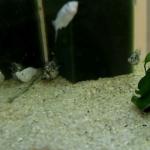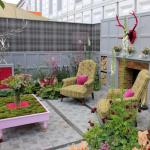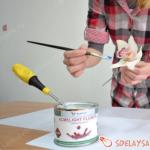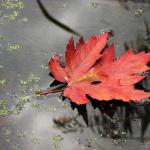Anthurium: rules of care and maintenance at home
If you want to have a spectacular plant on the windowsill that blooms all year round almost without interruption, choose anthurium. In summer, under favorable conditions, it is able to simultaneously hold 6-10 large flowers, in winter - on average, 3-4. Moreover, such a flowering is easy to achieve by growing anthurium at home, even without backlighting.
Each anthurium flower consists of a long cob inflorescence and a bracts of various colors: white, red, pink, green, brown, burgundy, etc. It is the color of the cover that sets the overall impression of the plant as a whole and often becomes the basis of the variety name. For example, Andre Anthurium of the Vivaro Pink variety is expected to have pink flowers, and the Black Queen variety reveals almost black bedspreads.
In nature, anthuriums are epiphytes and semi-epiphytes that live on the bark of trees or near them (in the remains of leaves, branches and other litter) in tropical forests. There are about 900 species of these plants, among which there are shrubs and lianas. But at home, only 3 types are widespread - Andre anthurium, Scherzer's anthurium and crystal anthurium (decorative leafy).
Most often, shops sell Andre anthurium - a shrub with heart-shaped leathery leaves. The stem of Andre's anthurium is initially short, but with age it lengthens to several tens of centimeters (in this case, rejuvenation is recommended by rooting the apex). The cover of the flower is glossy, with a bright shine and pronounced veins. The flower cob is straight. Anthurium Andre at home usually grows up to 0.4-0.5 m in height, in nature it is even larger and can reach 1 meter or more.
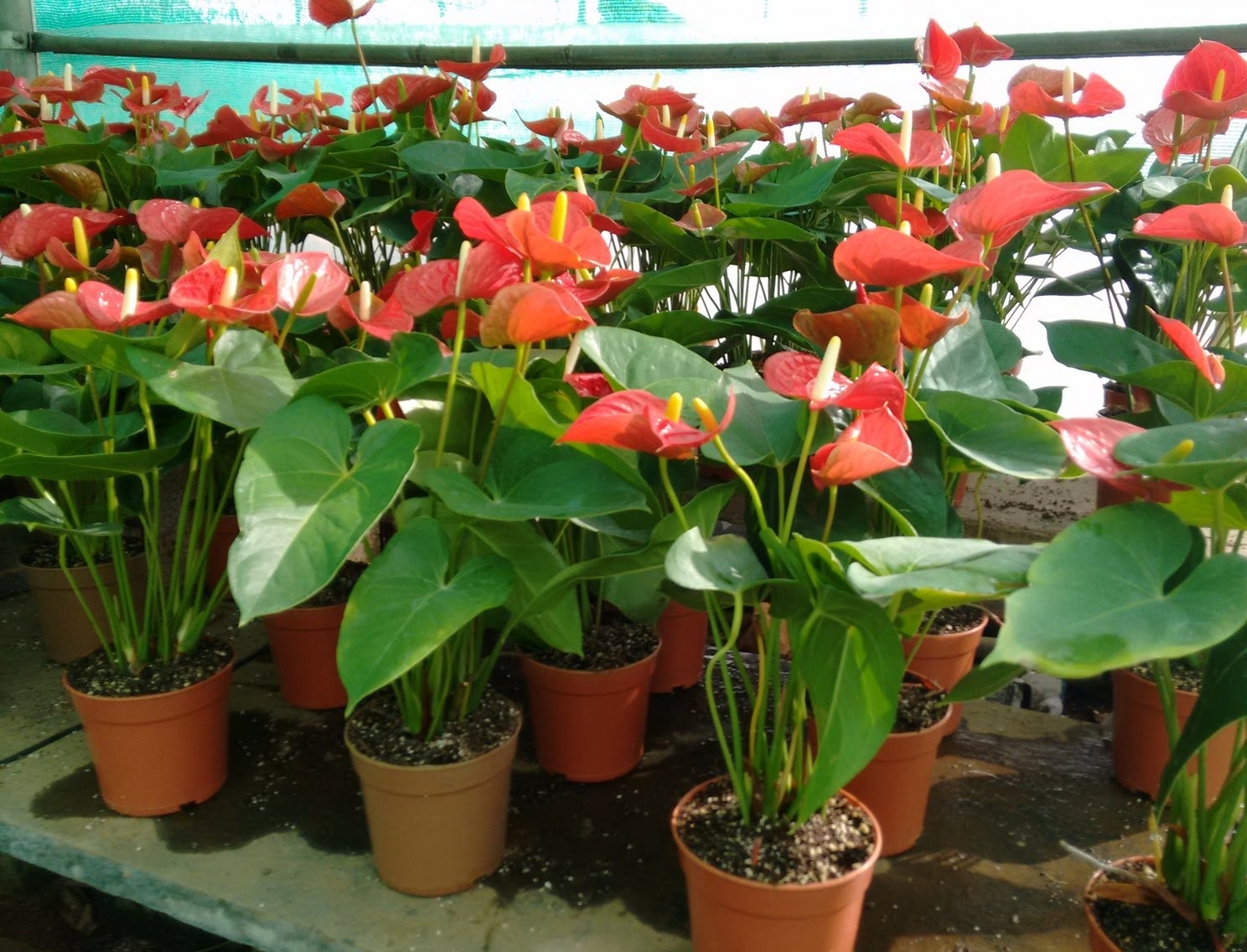 Anthurium Andre - the most abundant flowering species of anthuriums
Anthurium Andre - the most abundant flowering species of anthuriums Less often you can find Scherzer's anthurium, the ear of which is not straight, like Andre's, but is curved in a spiral, like a pig's tail. The leaves are also different, elongated, lanceolate. The cover of the flower is oval, dense, matte, without pronounced luster. Scherzer's Anthurium is more compact than Andre, its height is up to 30 cm.
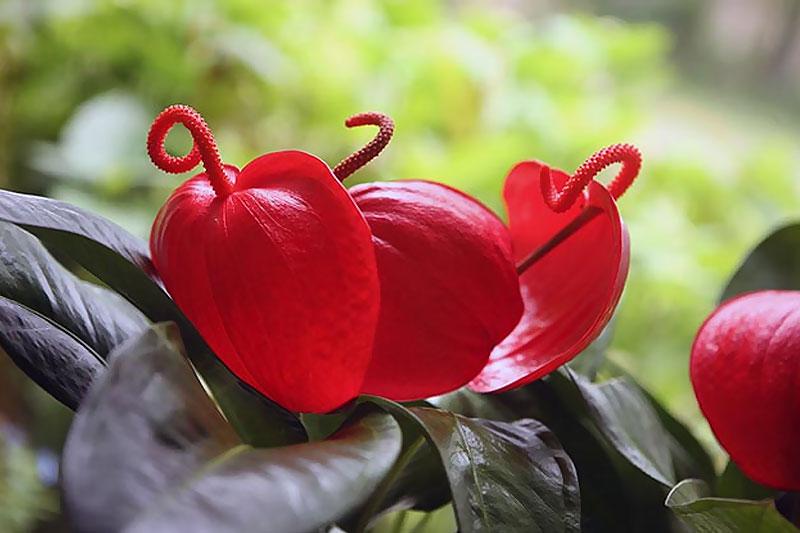 Scherzer's anthurium is often called the "flamingo flower" for the similarity of its flowers to a tropical bird
Scherzer's anthurium is often called the "flamingo flower" for the similarity of its flowers to a tropical bird Anthurium Crystal is an even rarer representative of anthuriums, the flowers of which have no decorative value. It is grown for the sake of large heart-shaped leaves with a spectacular pattern of silvery veins. The height of the crystal anthurium is about 45 cm.
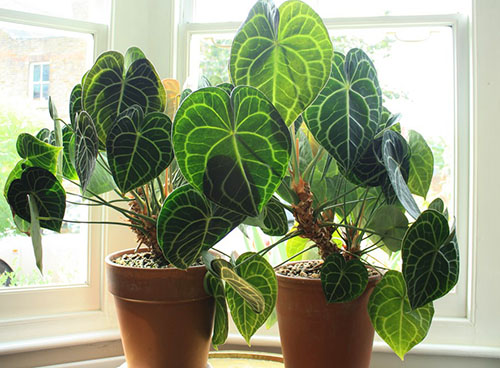 Crystal anthurium is prized for its decorative large leaves that can reach 40 cm in length and 35 cm in width
Crystal anthurium is prized for its decorative large leaves that can reach 40 cm in length and 35 cm in width For any type of anthurium, home care is almost identical.
Conditions for the growth and flowering of anthurium
Anthurium is often considered a moody plant. But it is not so. In fact, it is quite possible to grow anthurium at home, subject to simple rules regarding the choice of soil, irrigation regime and compliance with temperature and humidity conditions. Let's take a closer look at these rules.
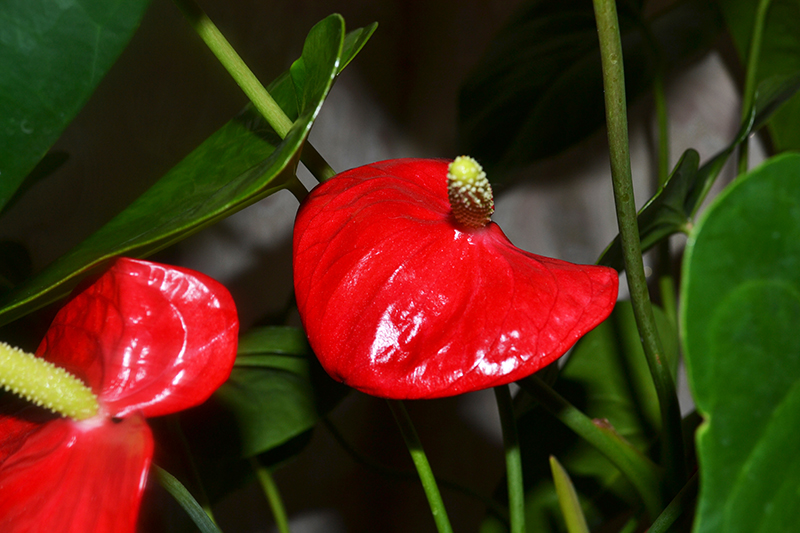 Anthurium at home requires warmth, high humidity and moderate soil moisture
Anthurium at home requires warmth, high humidity and moderate soil moisture As soon as you brought the anthurium home after purchase, the question arises of where to put the flower and what conditions to create for it in order to keep its presentation as long as possible. To do this, you will have to try to bring the conditions of home keeping anthurium closer to those to which he is accustomed in nature.
Location and lighting
After purchase, anthurium can be placed on any light-colored windowsill. However, direct sunlight should be avoided. Therefore, if you only have a southern window available, place the anthurium at a short distance from it (30-50 cm) or use shading with blinds or tulle during the day. If you put your homemade anthurium to fry directly in the sun without shading, then sunburn (yellow spots) will appear on the leaves, and the flowers will bloom on too short stalks.
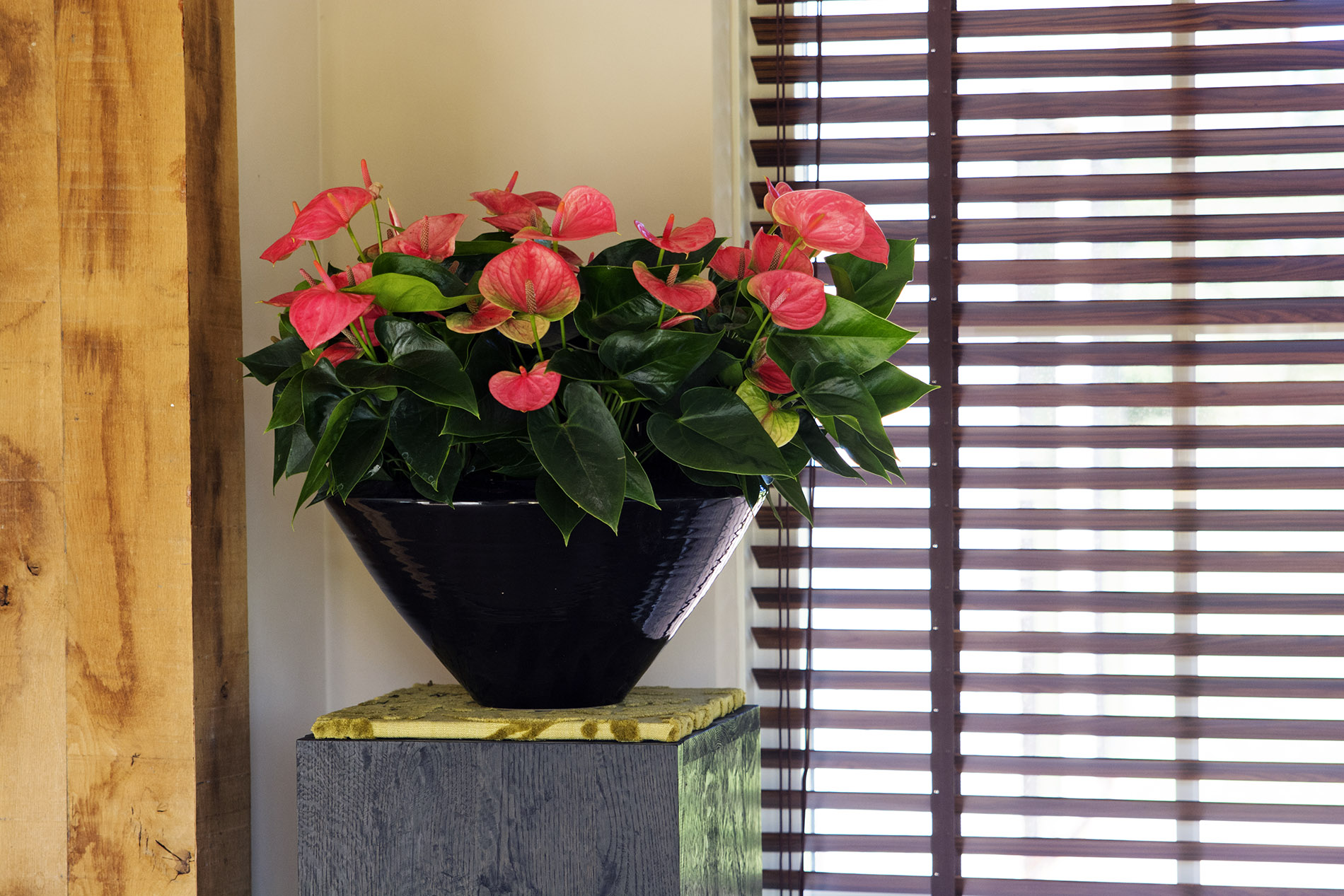 Anthurium near the south window must be shaded, for example, with blinds
Anthurium near the south window must be shaded, for example, with blinds The western and eastern window sills are considered the best for anthurium placement. Northern bright windows are also suitable. But if they are shaded from the street by trees, then the lighting may become insufficient. And this will not affect the condition of the plant for the better. The cuttings will become too long, the flowers will be small, the flowering will be scarce or even disappear altogether. Therefore, on such windows, the anthurium flower at home will have to be illuminated additionally using lamps (fluorescent, gas-discharge, LED).
Temperature
Anthurium is a thermophilic plant that does not tolerate cold and drafts. In summer, at the peak of flowering, the best temperatures for it are 25-30 ° C. In winter, special coolness is also not required, the minimum temperature of the content during this period is 16-18 ° C. Under such conditions, anthurium is able to exist for a long time without loss of decorative qualities.
Going beyond the temperature limits is also possible, but for a short time. If the temperature drops to 5 ° C at night (for example, in autumn, when the plant is kept on the balcony or on the terrace), then the leaves of anthurium will begin to turn yellow, growth will slow down or stop. At zero and negative temperatures, the indoor anthurium flower does not survive.
Air humidity
Anthurium is a resident of tropical forests, so he loves high air humidity, ideally 70-80%. If the air in the apartment is dry, it will have to be humidified by any suitable means.
The traditional way to moisturize a plant is by spraying. Anthurium can be sprayed with warm, settled water, making sure that the water falls only on the leaves, stem and aerial roots. Flowers should be covered or unsightly spots will remain on them. In winter, especially at cool temperatures, it is undesirable to spray directly on parts of the anthurium. It is better to spray the air around the plant with a fine spray.
You can increase the humidity by covering the surface of the substrate with moist sphagnum moss. It is well saturated with moisture and gradually evaporates it, moisturizing the air roots and, in general, the air around the plant. When using sphagnum, you should periodically check the degree of its moisture and, when drying, spray it with water from a spray bottle.
 The surface of the anthurium substrate is covered with a layer of moist sphagnum moss
The surface of the anthurium substrate is covered with a layer of moist sphagnum moss Another option, widely used among anthurium lovers: a flower pot is placed on a pallet filled with wet expanded clay. Expanded clay should be constantly sprayed, and he, in turn, will evaporate this moisture, humidifying the air.
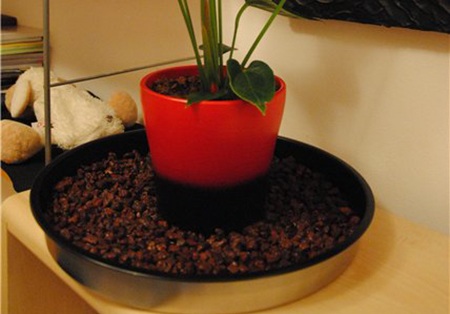 The pot with anthurium can be installed on a pallet with damp expanded clay or pebbles - to increase the humidity around the plant
The pot with anthurium can be installed on a pallet with damp expanded clay or pebbles - to increase the humidity around the plant Water containers, an aquarium, and a humidifier can also help humidify the air.
Anthurium refers to epiphytes or semi-epiphytes that can live practically without soil and extract useful substances from the bark of trees, fallen leaves and branches, forest litter. Therefore, you need a special one. It should be loose, allow moisture and air to pass through well, and retain nutrients.
There is a special soil for anthuriums on sale, for example, Polesskiy substrate “for anthuriums”. It contains peat, conifer bark, sand, coconut fiber and chips.
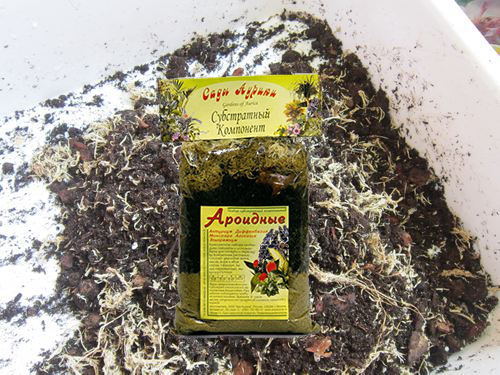 Soil for anthurium can be bought at a flower shop or you can compose yourself from the available components.
Soil for anthurium can be bought at a flower shop or you can compose yourself from the available components. However, it is not necessary to look for a special soil for it; it is easier to prepare it yourself by mixing the necessary components. The simplest, excellent composition for anthuriums: universal soil based on peat + bark in a 50:50 ratio.
In general, as a basis for soil for anthuriums, you can take universal or slightly acidic soil, pieces of bark and add any of the following components:
- perlite;
- vermiculite;
- pieces of charcoal (resists decay of roots well);
- sphagnum moss (small amount);
- coconut fiber (small amount);
- expanded clay chips;
- coarse sand.
On the stem of the anthurium, aerial roots develop, which, like ordinary roots, require nutrition. They come from the stem, some reach the substrate, others remain in their infancy. So that the aerial roots of anthurium do not dry out, the surface of the substrate in the pot is covered with sphagnum moss and sprayed regularly. This procedure perfectly moisturizes the aerial roots and increases the humidity of the air in general.
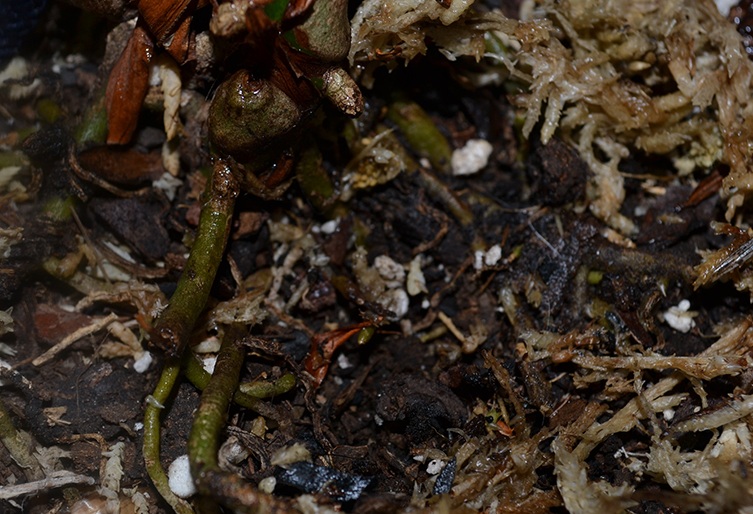 Anthurium roots that emerge on the surface of the substrate should be covered with sphagnum moss
Anthurium roots that emerge on the surface of the substrate should be covered with sphagnum moss Anthurium: how to care?
Anthurium is not a fast growing plant that requires 24/7 attention. Therefore, the main care activities - watering and feeding - are carried out carefully, without excessive fanaticism.
Despite the statements of some sellers, anthurium does not like damp, non-drying soil. In a constantly wet state, the anthurium root begins to rot and, without resuscitation procedures, dies very quickly.
Unfortunately, about 90% of the deaths of all domestic anthuriums are associated with the bay and rotting of the roots. Here the "golden rule" applies: it is better to underfill than to overfill. In other words, anthurium quite normally tolerates a rather long drying, and one good bay can easily kill it.
In order for anthurium to settle on your windowsill for a long time, watering it must be strictly regulated. It is enough to water it after drying the substrate in half the pot. Some growers use the weight of the pot to determine how dry the soil is. Before watering the anthurium, they raise the pot. If it's light, then it's time to water. If you feel heaviness, you can wait.
Even in the summer heat, anthurium needs watering no more than once every 1-1.5 weeks. In winter - even less often, about once every 2-3 weeks (depending on temperature and humidity).
Watering anthurium at home is carried out with warm (above room temperature, about 30-34 ° C), settled water. The water that has flowed out into the sump must be drained immediately so that it does not stagnate.
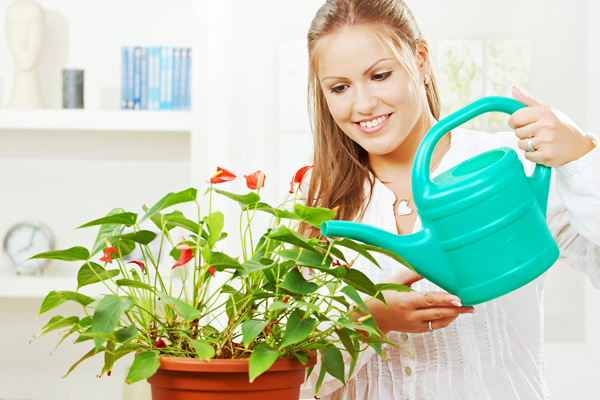 Very often, anthuriums die from waterlogging of the substrate, so they should be watered very carefully and only with warm water.
Very often, anthuriums die from waterlogging of the substrate, so they should be watered very carefully and only with warm water. Top dressing
If you have an anthurium, caring for it should include periodic feeding. In summer, to stimulate flowering, fertilizers are used for flowering plants with a high content of potassium and phosphorus. In winter, if the plant does not bloom, feeding is stopped. If it blooms, you can feed it according to the established scheme. Fertilizer for anthurium is applied every 2-3 weeks.
Crystal anthurium, of course, is fed with fertilizer for decorative deciduous plants.
Anthurium is very responsive to organic feeding. You can use an infusion of chicken manure or mullein - no more than once a month.
An important event for the care of anthurium is transplantation
The first transplant is usually done after purchasing the plant. Anthurium easily tolerates a transplant even in a flowering state, so there is no need to wait for the end of flowering.
In the future, young anthuriums are transplanted every year, and adults - every 2-3 years. The best time for this event is spring. Although, if necessary, for example, if you suspect root rot or a bay, the transplant can be performed at any time of the year. Read about anthurium transplantation.
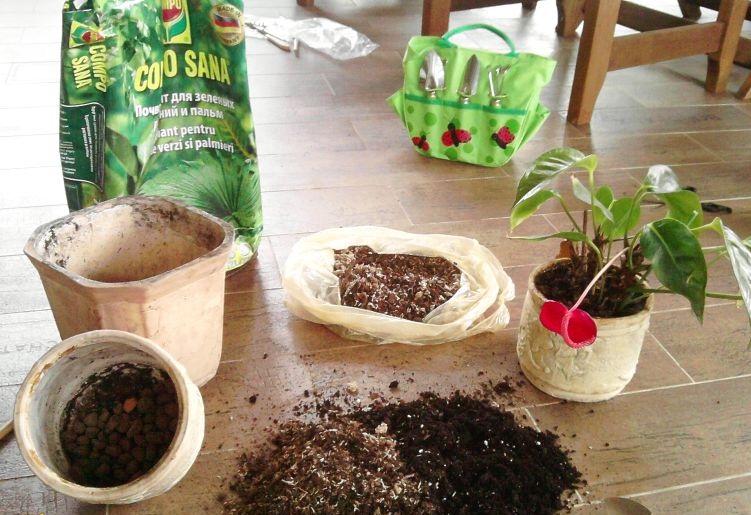 When transplanting anthurium, you should carefully handle the roots, they are very fragile and can break from careless movement
When transplanting anthurium, you should carefully handle the roots, they are very fragile and can break from careless movement Valuable tips for caring for anthurium at home are given in the video clip:
Caring for home flowers anthurium, in principle, is simple. Most importantly, with the right approach, this plant will surely thank you. Anthurium of Andre and Scherzer - year-round flowering, crystal anthurium - with large spectacular leaves.
